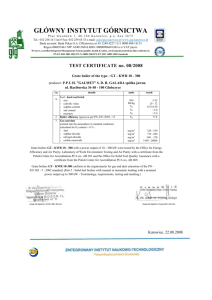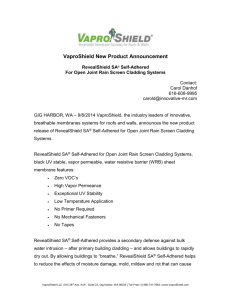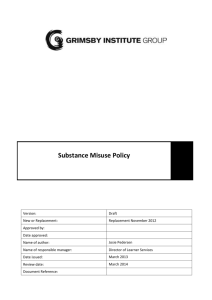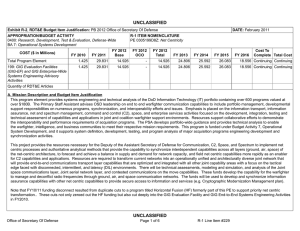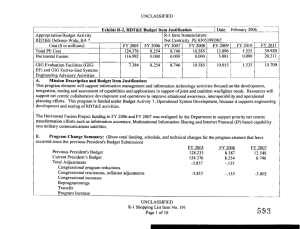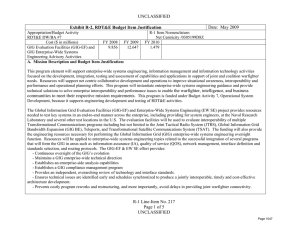Document 10492583
advertisement
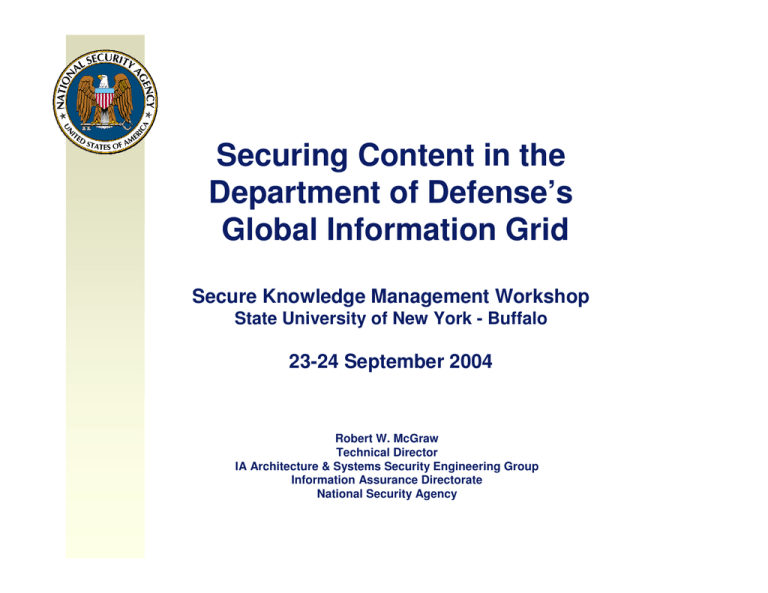
Securing Content in the Department of Defense’s Global Information Grid Secure Knowledge Management Workshop State University of New York - Buffalo 23-24 September 2004 Robert W. McGraw Technical Director IA Architecture & Systems Security Engineering Group Information Assurance Directorate National Security Agency Vision for DoD Transformation The Department of Defense is transforming itself through the Global Information Grid (GIG) in pursuit of information superiority and net-centric warfare (NCW) “The two truly transforming things might be in information technology and information operating and networking… connecting things in ways that they function totally differently than they had previously.” “And if that’s possible…then possibly the single most transforming thing in our Force will not be a weapon system, but a set of interconnections and a substantially enhanced capability because of that awareness.” Donald Rumsfeld, Secretary of Defense Town Hall Meeting, Pentagon, 9 August 2001 “…the outcome we must achieve: fundamentally joint, network-centric, distributed forces capable of rapid decision superiority and massed effects across the battlefield” Donald Rumsfield, Secretary of Defense Secretary’s Foreword to Transformation Planning Guidance, April 2003 2 GIG Vision Fundamental transformation in information/content management, communications, and information assurance. • • IP Transport Backbone Fiber Satellite Wireless Highly Available Service Oriented Architecture Users Mission Area-Specific Content Providers and Capabilities Dynamically Created COIs Sensors Intel Finance Weapon Systems Personnel Logistics Core Enterprise Services Unique Mission Specific services • Content Providers • Users Provided by mission specific entities Many mission areas (e.g. business, financial, personnel, command and control, intelligence, warfighting) Consumers of the GIG content. DoD Intelligence Community, Allies and coalition partners, other government, state/local… Command & Control Etc. IP-Based Transport Backbone • Terrestrial • Space Based • Tactical Wireless Discovery Collaboration User Assistant Storage Systems Management Security/IA Mediation Core Enterprise Services Messaging Applications 3 GIG Transformation Drives Focus on IA and Securing Content Current (Conceptual) Future (implied by GIG vision) • Separate networks that rely on physical, cryptographic, and administrative isolation to protect content of different sensitivity • Isolation approach restricts ability to share content by creating stovepipes with limited bridging Top Secret Secret Unclassified Warfighter, Business , IC Mission Areas Warfighter, Business, IC Mission Areas Computing Infrastructure Computing Infrastructure Computing Infrastructure Transport Transport Transport Management & Control Management & Control Management & Control Limited bridging Warfighter, Business, IC Mission Areas Warfighter Domain Business Domain IC Domain Core Enterprise Services Converged IP Backbone ta l n me on e r Inc voluti E Satellite Tactical Terrestrial Fiber Wireless INTERNET Integrated Enterprise Management and Control • Common, converged networks that rely on advanced Information Assurance technologies and trustworthy systems to protect content of different sensitivity • Ubiquitous Information Assurance enables content sharing through logical domains and communities of interest 4 Some Considerations for Securing Content in the GIG Goal: Ensure that the content relied upon by GIG users is properly protected, available, reliable, and authorized for use, in a common, coordinated manner. • Security Risk Assessment • Content types • Reliability and trustworthiness of content • Availability of content • Robustness of systems • Access control 5 Access Control Decision - Traditional • Object-level access control will become the primary protection mechanism for segregating information at different sensitivity levels • Traditional access control approaches will not suffice to support the change in paradigm from need-to-know to need-to-share because they: Demand satisfaction of clearance and needto-know and assume that the risk of granting access is unacceptable if both are not met – no exception Assume uniformity of people, IT components and situational conditions across the enterprise and time Are inflexible 6 Access Control Decision – Risk and Policy Based • A concept referred to as Risk Adaptable Access Control (RAdAC), is envisioned that will determine access based on: The security risk in granting the access Operational necessity for access The enterprise’s policy for the balance between the two for various situations. Operational necessity can trump security risk Security risk is primarily a function of the people, IT components, content object being accessed, the environment in which they exist and historical access. Measurement of risk is envisioned to be done by ‘intelligent’ system processes, that will operate on a set of inputs and provide a risk level. • Multi Factor Access Control Risk Decision • Policy Based Evaluation of Access Request • Flexibility in Response to Operational Need 7 Access Control - Inputs Other Inputs Characteristics of: • The person (or other entity) to be given access • Situational Awareness (e.g. threat level condition) • • The object or resource to be accessed • The IT components involved and their pedigree Heuristics – past decisions, knowledge of total enterprise risk • • The environment (e.g. location, facility) in which the person and IT components are operating Digital Access Control Policy – specifies levels of acceptable risk and required operational need " "# " $% & ' ! 8 Access Control - Context The access control enforcement would be distributed to various systems Entity / User Access Control Enforcement Request to access resource A resource could be any content to which access must be controlled. Static data, real time video, web service, web page, and so forth. Request to access resource Resource (Policy Enforcement Point (PEP)) Access request Risk Knowledge Allow / Deny Risk-Adaptable Access Control Decision Access Control Capabilities (Policy Decision Point (PDP)) Retrieval of Access Rights, Privileges, & Attributes Access Control Policy Retrieval Policy Management Authorization Polices Authentication Identity Management User Identities Situational Awareness Content Labeling Management Authorization Management Entity/User Profile Metadata Catalog Environmental Factors 9 Some Technology and Research Challenges • The whole Information Assurance vision for the evolution of the GIG is replete with technology and research topics. • The access control concepts just discussed generate many. Here are a few: Calculating security risk of access decisions – real time Determining the affect of access decisions on overall enterprise security Quantifying trust in people – through a security clearance or otherwise Determining a person’s operational need Quantifying and calculating the level of trust for various identification and authentication mechanisms Automatic determination and labeling of content protection requirements in accordance with enterprise policies, including subpart labels Quantifying the trust level of IT components and systems. Determining the location of IT components/client systems and quantifying the adversarial threat in that location Heuristics as applied to access control decisions and improving access control decisions Providing and managing digital security policies – dealing with conflict Providing affordable, trustworthy components 10 Summary • • • The DoD, via implementation of the Global Information Grid, is undergoing a transformation in the way it manages, communicates and secures its information content. Information Assurance is critical to the success of the GIG vision. The GIG will be realized through a phased implementation over 15+ years which: Ensures Information Assurance capabilities, guidance, and policies exist to safely evolve to the next GIG increment Ensures the transformation does not become so complex that it cannot be adequately understood and evaluated • For more information on Information Assurance for the GIG, please visit the Information Assurance Technical Framework (IATF) Forum website at www.iatf.net. GIG 2020 Vision As Planned I1 V3 V1V2 I2 V3 V1V2 I3 V3 V1V2 2016 2012 2006 2008 11

